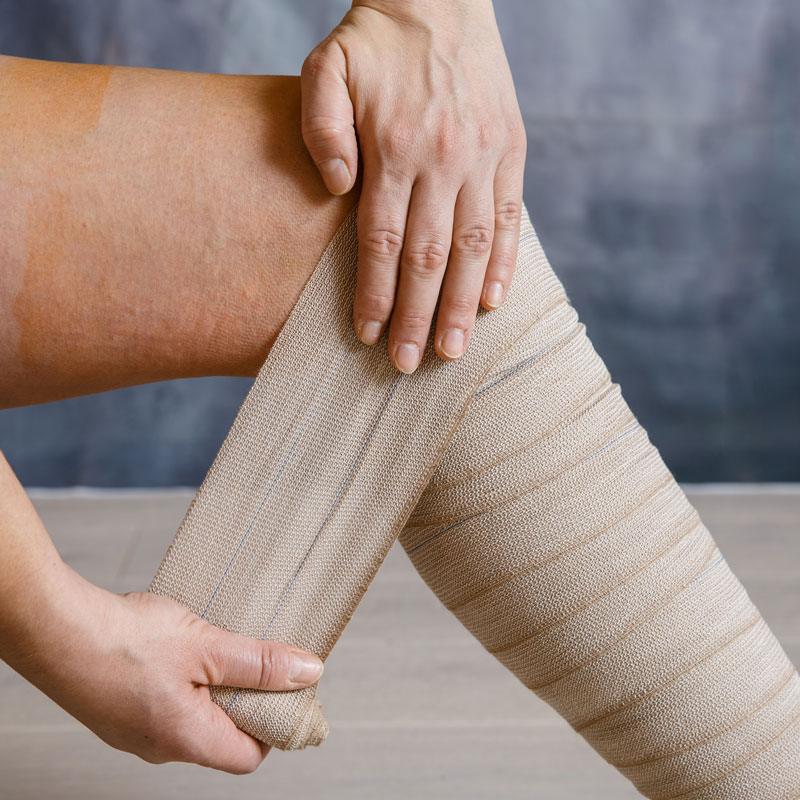Venous Ulcers
Venous Ulcer Treatments in Phoenix
Venous ulcers are sores caused by a restriction to blood flow or issues with the veins on your legs, typically near the ankle. These sores can take weeks or months to heal and put you at risk of complications like infection. At Arizona Vein & Laser Institute, we specialize in the diagnosis and treatment of venous and vascular diseases and disorders. We can make a venous ulcer diagnosis quickly and begin aggressive venous ulcer treatment. Call us today to schedule a consultation if you are exhibiting symptoms of a venous ulcer.
What Are Venous Ulcers?
A venous ulcer is an open sore that develops when the veins in the legs don’t efficiently push blood back up to the heart, causing a backup of blood in the veins, which builds up pressure. Over time, if this pressure is not treated, the excess pressure and fluid can cause the formation of an open sore. Most venous ulcers form on the leg above the ankle.

Venous Ulcer Symptoms
As blood pools in the veins of the lower leg, fluid, and blood cells leak out through the skin, causing itchy, thin skin in the area. Eventually, it will lead to a skin disorder called stasis dermatitis, which is the earliest warning sign of venous insufficiency. Other early warning signs include:
- Leg swelling, cramping, and heaviness.
- Dark red, purple, or brown skin that is hardened.
- Itching or tingling at the site.
Without intervention and treatment, you are at risk of a venous ulcer. Venous ulcer symptoms include:
- A shallow sore with a red base.
- Yellow tissue surrounding a sore.
- Unevenly shaped borders around the sore.
- Shiny, tight, warm, hot, discolored skin around the sore.
- Leg pain.
- Infection, pus, or fluid oozing from the sore.
Venous Ulcer Causes
Venous ulcers are caused by high pressure in the veins of the lower leg. Each vein has a one-way valve that allows for efficient blood flow upwards toward the heart. If the valves are weak or the veins are scarred or blocked, the blood flows backward and pools in the legs. This condition is called venous insufficiency. Over time, it will cause high pressure in the lower leg veins, which prevents sufficient nutrients and oxygen from getting to the tissues, causing cell death, tissue damage, and the formation of a wound or open sore.
Venous Ulcer Diagnosis
Our specialists will likely be able to diagnose a venous ulcer solely through a physical examination. We may also perform testing, including:
- Ankle-brachial Index – During this procedure, we take blood pressure readings of your arms and legs.
- Doppler Study – During this procedure, we listen to the blood flow through your veins.
- Diagnostic Imaging – Diagnostic imaging scans, such as CT scans, can identify damaged or poorly functioning valves.
Venous Ulcer Treatment
Venous ulcers will not heal on their own. If you suspect you’re showing venous ulcer symptoms, you should make an appointment with us right away for an evaluation. Without swift venous ulcer treatment, you are at risk of infection and other complications. The longer a venous ulcer exists, the more at risk you are for permanent tissue damage, life-threatening infections, and gangrene. We will determine the best method of venous ulcer treatment based on the size and progression of the ulcer, your health and lifestyle, and the location of the ulcer.
We may recommend:
- Antibiotics to treat infection.
- Compression stockings or bandages.
- Antibacterial ointments.
- Pain relief.
- Nerve calming therapies.
- Debridement to remove dead tissue and debris.
- Specialized bandages and wound dressings.
- Daily wound cleaning.
- Skin grafts.
- Venous disease treatment.
You can reduce your risk of venous ulcers or prevent one from occurring again by:
- Maintaining a healthy diet and lifestyle.
- Managing chronic conditions like diabetes.
- Losing weight.
- Stopping smoking.
- Maintaining treatment for high blood pressure.
- Taking blood thinners to prevent blood clots.
- Periodically raise your legs when seated to avoid blood pooling.
Schedule a Consultation with Our Specialists
Call us today or contact us online to schedule a consultation or venous ulcer diagnosis from our specialists at Arizona Vein & Laser Institute. We have six convenient locations in Arizona, including Mesa, Glendale, Surprise, Avondale, Chandler, and Phoenix. Each location is staffed with highly-skilled medical specialists and cardiovascular surgeons. We specialize in diagnosing and treating vascular and venous disorders and diseases.
